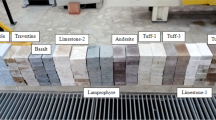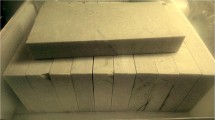Abstract
Rock cutting with an abrasive waterjet system has been attempted in mining and construction fields. In abrasive waterjet cutting, the overall operating cost depends on the cost of the consumed abrasive. For this reason, it is important to identify an optimum abrasive feed rate for cost and performance efficiency. In this study, the concept of the abrasive/water ratio in volume (i.e., mixing rate of the abrasive and water amount) was introduced to explore the optimum feed rate for the cutting performance according to the water flow rate. Rock cutting tests were performed on intact granite specimens at different abrasive/water ratios. The test results were analyzed based on the effect of the abrasive feed rate in a constant water flow rate condition and on the effect of the water flow rate in a constant abrasive feed rate condition, respectively. In addition, the ratio of the abrasive particle size to the abrasive–water mixture flow space (i.e., mixing tube size) was considered and analyzed to determine the optimum abrasive/water ratio. Under the conditions given in this study, the optimum abrasive/water ratio ranges from 0.08 to 0.20 and tends to increase with an increase in the average particle size, particle size uniformity of the abrasive, and mixing tube size. In the performance analysis of rock cutting, a higher water flow rate causes a better cutting efficiency; meanwhile, the optimum abrasive feed rate achieves the maximum cutting performance. These findings can help to estimate the amount of abrasive required for efficient rock cutting.












Similar content being viewed by others
References
Alsoufi MS, Suker DK, Alhazmi MW, Azam S (2017) Influence of abrasive waterjet machining parameters on the surface texture quality of carrara marble. J Surf Eng Mater Adv Technol 7(02):25
Aydin G, Karakurt I, Aydiner K (2011) An investigation on surface roughness of granite machined by abrasive waterjet. Bull Mater Sci 34(4):985–992
Aydin G, Karakurt I, Aydiner K (2013) Prediction of the cut depth of granitic rocks machined by abrasive waterjet (AWJ). Rock Mech Rock Eng 46(5):1223–1235
Brown ET (1981) Rock characterization testing and monitoring. Pergamon Press, Oxford
Cho GC, Oh TM (2011) Excavation system using a water jet, and excavation method using the same. US Patent Application 13/876,782
Ciccu R, Grosso B (2014) Improvement of disc cutter performance by water jet assistance. Rock Mech Rock Eng 47(2):733–744
Doreswamy D, Shivamurthy B, Anjaiah D, Sharma NY (2015) An investigation of abrasive water jet machining on graphite/glass/epoxy composite. Int J Manuf Eng 2015:1–11 (Article ID 627218)
Engin IC (2012) A correlation for predicting the abrasive water jet cutting depth for natural stones. S Afr J Sci 108(9–10):1–11
Gryc R, Hlaváč L, Mikoláš M, Šancer J, Daněk T (2014) Correlation of pure and abrasive water jet cutting of rocks. Int J Rock Mech Min Sci 65:149–152
Hashish M (1984) A modeling study of metal cutting with abrasive waterjets. J Eng Mater Technol 106(1):88–100
Hashish M (2011) AWJ cutting with reduced abrasive consumption. In: 2011 WJTA-IMCA Conference and Expo, September 19–21, Houston, Texas, Paper A4
Henning A, Westkämper E (2003) Modelling of wear mechanisms at the abrasive waterjet cutting front. In: Proceeding of the 2003 American Water Jet Conference, Texas, USA, Paper 3-A
Henning A, Miles P, Stang D (2011) Efficient operation of abrasive waterjet cutting in industrial applications. In: Proceedings of 2011 WJTA-IMCA Conference, Texas, USA, Paper A1
Joo GW (2014) Effect of abrasive characteristics on waterjet rock cutting. Master Thesis, KAIST pp 151
Karakurt I, Aydin G, Aydiner K (2012) An experimental study on the depth of cut of granite in abrasive waterjet cutting. Mater Manuf Process 27(5):538–544
Karakurt I, Aydin G, Aydiner K (2014) An investigation on the kerf width in abrasive waterjet cutting of granitic rocks. Arab J Geosci 7(7):2923–2932
Kulekci MK (2002) Processes and apparatus developments in industrial waterjet applications. Int J Mach Tools Manuf 42(12):1297–1306
Lu Y, Tang J, Ge Z, Xia B, Liu Y (2013) Hard rock drilling technique with abrasive water jet assistance. Int J Rock Mech Min Sci 60:47–56
Momber AW (2001) Energy transfer during the mixing of air and solid particles into a high-speed waterjet: an impact-force study. Exp Thermal Fluid Sci 25(1):31–41
Momber AW (2004a) Wear of rocks by water flow. Int J Rock Mech Min Sci 41:51–68
Momber AW (2004b) Synergetic effects of secondary liquid drop impact and solid particle impact during hydro-abrasive erosion of brittle materials. Wear 256(11):1190–1195
Oh TM, Cho GC (2014) Characterization of effective parameters in abrasive waterjet rock cutting. Rock Mech Rock Eng 47(2):745–756
Oh TM, Cho GC (2016) Rock cutting depth model based on kinetic energy of abrasive waterjet. Rock Mech Rock Eng 49(3):1059–1072
Song D, Wang E, Liu Z, Liu X, Shen R (2014) Numerical simulation of rock-burst relief and prevention by water-jet cutting. Int J Rock Mech Min Sci 70:318–331
Summers DA, Woelk KH, Oglesby KD, Galecki G (2012) Method and apparatus for jet-assisted drilling or cutting. US Patent No 8,257,147
Tazibt A, Parsy F, Abriak N (1996) Theoretical analysis of the particle acceleration process in abrasive water jet cutting. Comput Mater Sci 5(1):243–254
Acknowledgements
This research was supported by a grant (19SCIP-B105148-05) from the Construction Technology Research Program funded by the Ministry of Land, Infrastructure, and Transport of the Korean government.
Author information
Authors and Affiliations
Corresponding author
Additional information
Publisher’s Note
Springer Nature remains neutral with regard to jurisdictional claims in published maps and institutional affiliations.
Rights and permissions
About this article
Cite this article
Oh, TM., Joo, GW. & Cho, GC. Effect of Abrasive Feed Rate on Rock Cutting Performance of Abrasive Waterjet. Rock Mech Rock Eng 52, 3431–3442 (2019). https://doi.org/10.1007/s00603-019-01784-x
Received:
Accepted:
Published:
Issue Date:
DOI: https://doi.org/10.1007/s00603-019-01784-x




